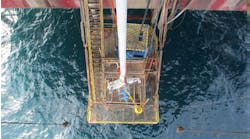Offshore staff
LONDON – Westwood Global Energy Group sees major potential but also challenges ahead for deepwater field development off Namibia.
The recent Graff and Venus discoveries in the Orange basin, operated respectively by Shell and TotalEnergies, have opened up multiple new oil plays in the region.
Graff-1 was reportedly a light oil discovery in what are assumed to be Upper Cretaceous sands in offshore block 2913A. According to Westwood, Shell is currently drilling a second well at La Rona, probably designed to appraised the discovery before confirming the potential for a commercial development.
Latest indications suggest Graff could contain 1 bbl of oil and 5-6 tcf of gas.
The Venus 1-X well in block 2913B encountered around 84 m (275 ft) of net oil pay in a Lower Cretaceous reservoir, with rumors of a multi-billion bbl resource.
According to Graeme Bagley, head of Global Exploration & Appraisal at Westwood, analysis suggests the Lower Cretaceous Venus play could potential cover an area of up to ~58,000 sq km (22,394 sq mi), comparable to the Upper Cretaceous offshore Suriname-Guyana. So a similar-scale oil province is possible assuming that the traps are present and the deepwater reservoirs are widespread and of sufficient quality.
All the prospective acreage appears to have been snapped up already under fiscal terms that reflect the basins’ high-risk frontier nature.
Venus is ~325 km (202 mi) offshore and in 3,000 m (9,842 ft) water depth and would be the deepest water development globally to date. Shell holds the current record with Stones in 2,900 m (9,514 ft) of water in the US Gulf of Mexico.
But deepwater adds cost and engineering complexity, Bagley said, and the challenges may be exacerbated by a potentially high gas content in Graff and Venus.
TotalEnergies reported associated gas, suggesting either a free gas cap or a high gas-oil ratio, with significant volumes of gas dissolved within the liquid hydrocarbons.
Development wells would have to bypass any gas cap that may be present, and produced gas might have to be carefully managed, possibly reinjected to the reservoirs until an economic route for taking the produced gas to market can be confirmed.
He pointed out that gas management has already proven to be a challenge off Suriname-Guyana, with some of the Surinamese discoveries at risk of being stranded due to the high gas content and the absence of a large local market.
Westwood’s current understanding of the oil and gas source kitchen off Namibia is that any hydrocarbons generated would likely have a higher gas content to the south and the east of the two discoveries.
Venus’ areal extent is reportedly ~600 km (373 mi), with the discovery well encountering an 84-m (275-ft) hydrocarbon column, potentially in the thickest part of the reservoir. Farther out, the hydrocarbon column could be thinner, making economic production trickier.
The number of barrels of oil that can be produced from each well will be critical to the ultimate recovery/commerciality, Bagley added.
Graff is in shallower water, at ~2,000 m (6,562 ft), and follow-on prospectivity is said to have been identified in an adjacent foldbelt and may already have been tested at La Rona.
ExxonMobil brought the Liza field off Guyana onstream within five years of discovery and a similar timeline is possible for Graff and Venus, Bagley claimed, if the volumes can be confirmed and the technical challenges addressed.
4/8/2022



